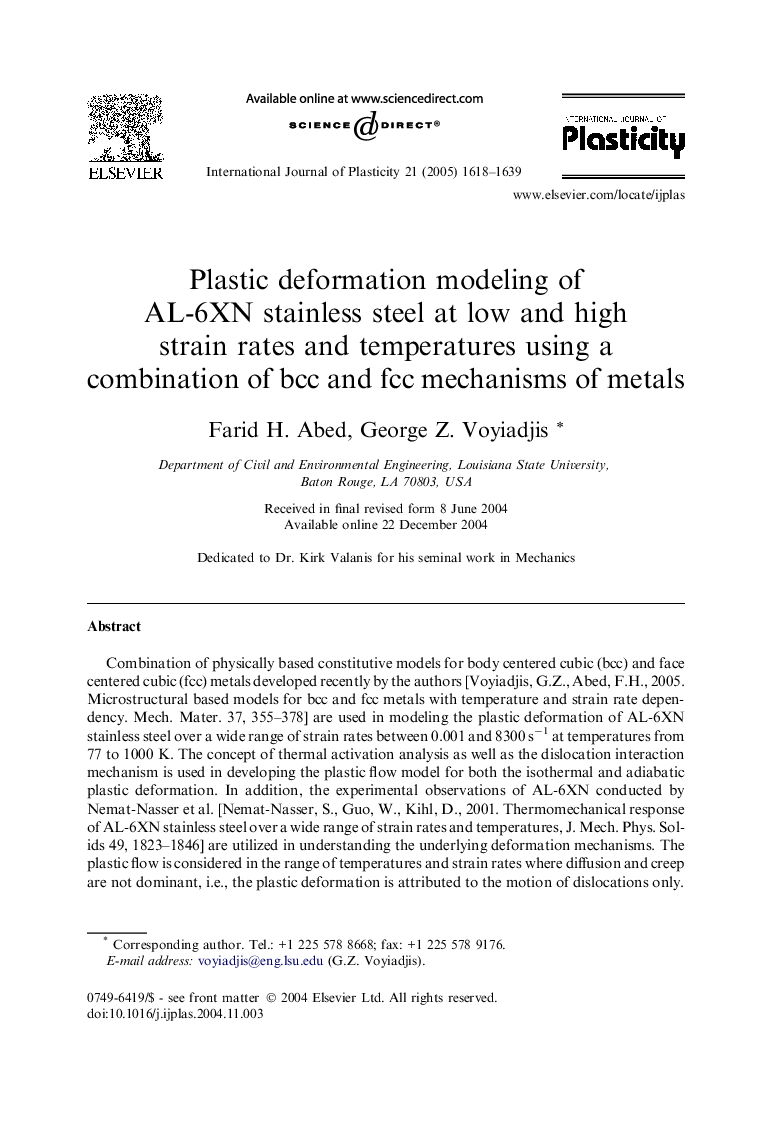| کد مقاله | کد نشریه | سال انتشار | مقاله انگلیسی | نسخه تمام متن |
|---|---|---|---|---|
| 9707210 | 1465719 | 2005 | 22 صفحه PDF | دانلود رایگان |
عنوان انگلیسی مقاله ISI
Plastic deformation modeling of AL-6XN stainless steel at low and high strain rates and temperatures using a combination of bcc and fcc mechanisms of metals
دانلود مقاله + سفارش ترجمه
دانلود مقاله ISI انگلیسی
رایگان برای ایرانیان
کلمات کلیدی
موضوعات مرتبط
مهندسی و علوم پایه
سایر رشته های مهندسی
مهندسی مکانیک
پیش نمایش صفحه اول مقاله

چکیده انگلیسی
Combination of physically based constitutive models for body centered cubic (bcc) and face centered cubic (fcc) metals developed recently by the authors [Voyiadjis, G.Z., Abed, F.H., 2005. Microstructural based models for bcc and fcc metals with temperature and strain rate dependency. Mech. Mater. 37, 355-378] are used in modeling the plastic deformation of AL-6XN stainless steel over a wide range of strain rates between 0.001 and 8300 sâ1 at temperatures from 77 to 1000 K. The concept of thermal activation analysis as well as the dislocation interaction mechanism is used in developing the plastic flow model for both the isothermal and adiabatic plastic deformation. In addition, the experimental observations of AL-6XN conducted by Nemat-Nasser et al. [Nemat-Nasser, S., Guo, W., Kihl, D., 2001. Thermomechanical response of AL-6XN stainless steel over a wide range of strain rates and temperatures, J. Mech. Phys. Solids 49, 1823-1846] are utilized in understanding the underlying deformation mechanisms. The plastic flow is considered in the range of temperatures and strain rates where diffusion and creep are not dominant, i.e., the plastic deformation is attributed to the motion of dislocations only. The modeling of the true stress-true strain curves for AL-6XN stainless steel is achieved using the classical secant modulus for the case of unidirectional deformation. The model parameters are obtained using the experimental results of three strain rates (0.001, 0.1, and 3500 sâ1). Good agreement is obtained between the experimental results and the model predictions. Moreover, the independency of the present model to the experiments used in the modeling is verified by comparing the theoretical results to an independent set of experimental data at the strain rate of 8300 sâ1 and various initial temperatures. Good correlation is observed between the model predictions and the experimental observations.
ناشر
Database: Elsevier - ScienceDirect (ساینس دایرکت)
Journal: International Journal of Plasticity - Volume 21, Issue 8, August 2005, Pages 1618-1639
Journal: International Journal of Plasticity - Volume 21, Issue 8, August 2005, Pages 1618-1639
نویسندگان
Farid H. Abed, George Z. Voyiadjis,